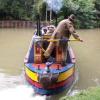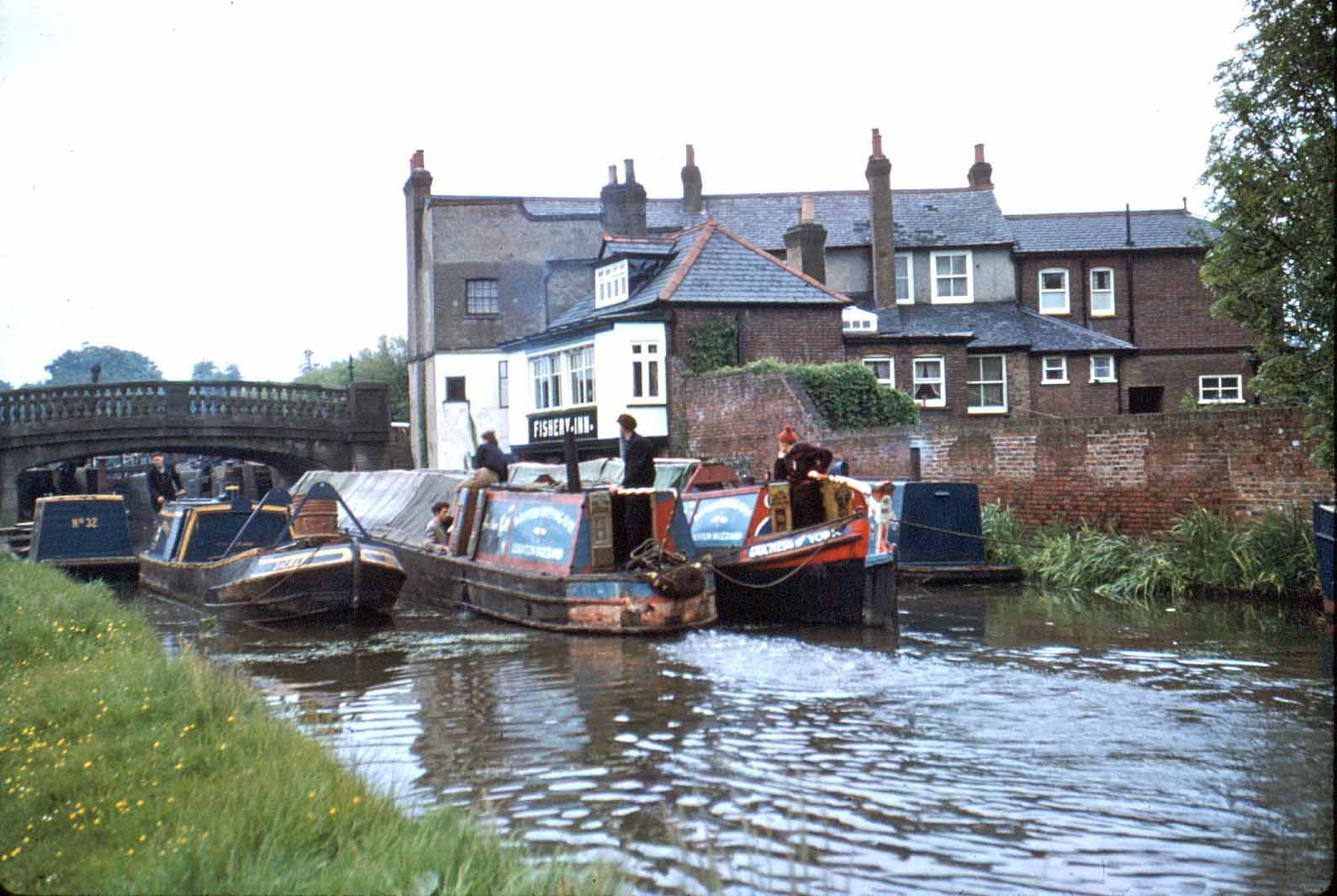-
Posts
38,163 -
Joined
-
Last visited
-
Days Won
81
Content Type
Profiles
Forums
Events
Gallery
Blogs
Store
Everything posted by alan_fincher
-
My one observation is that the JP2 tends to be more sought after than the JP3, and hence to change hands at more money. Nowt wrong with a 3 pot, of course, but I would want the twin. Also when I fave see them in a GUCCCo boat engine room the JP3 leaves things rather too oovercrowned.
-
I agree with Tony. This certainly looks like a twin coil calorifier. Each picture shows a pair of connections one vertically above the other, and it would be surprising if one picture didn't show the connections for one coil and the other picture those for the other coil. As well as Tony's "blow in them" method, you could also lay it flat on its side with a pair of connectors at the highest point, and pump water down one connector - it should then flow out the other one. The lowest connector, with part of a plastic Hep2O still attached, would logically be "cold water in". The only thing that surprises me is just how close it is to the lower calorifier connection - no reason why it should not be, but I can't recall seeing one like that. The other thing that surprises me is that all 4 calorifier connections have got an adapter which (assuming you don't remove them) means you would need unusually oversized pipe and connectors. I can't think why you would use very much larger hardware to connect to the calorifier than the "native" connections that the calorifier has. It's obviously not new. Do you know its history.
-
Oh I see! The pillows are supposed to be on the right hand side of the boat! That;s what I have been doing wrong!
-

Logic of restricted lock flight hours to preserve water
alan_fincher replied to Steve Bassplayer's topic in General Boating
Many of the "candlestick" locks on the Grand Union Birmingham main line have (often automated) back pumps installed, meaning that water used through lockage gets pumped back above the lock involved. If that were the case at Calcutt it would mean water levels there are to some extent self maintaining, whereas at Hillmorton once it has run down it can't be put back up again. That said my ageing memory can't recall obvious signs of back-pumping at Calcutt, so I am rather doubting that this could be an explanation. Anybody know? -

Anyone know whether the Napton flight is operating reduced hours?
alan_fincher replied to Wafi's topic in Stoppages
There are stoppage notices for Marston Doles & Claydon. However these show a start date of July 1st, so there isn't (quite) yet an actual stoppage. -
I've never heard of Craftsman Engines. Can you provide a link to somewhere that has details of them, please?
-
Only if you also put back the missing 31 feet 6 inches!
-
Yes, but Sickle had its Ram removed by British Waterways at some date around 1957. So as it is currently restored, it is historically accurate as it worked as a BW maintenance boat from that year onwards. Tycho, on the other hand had its Ram left untouched by BW. and it even managed to retain it whilst working for Mattys. Removing it would be contra to its history -- as a shortened Motor, it has never not had a ram.
-
Now that would be more or less the ultimate act of vandalism.... But, on the other hand, they are more than welcome to get rid of the Blue Tops!
-
No obvious "gotchas" I can see, but I am always suspicious when the broker has had their own pre-sale survey done, (presumably by their own "tame" surveyor). I wouldn't trust anything in that survey, and realise you have already understand the need to commission your own. A few other random points:- I personally dislike having a completely squared odd counter stern. It is not helpful when trying to get going if the bow has been pushed away from the bank, but the stern is still touching it. A round stern will not attempt to run along the piling, but a square one may well try to. Many people have a strong dislike of large area of painted wall paneling or ceilings. It has often been done as a cheap way to brighten a boat up for sale. It may be obscuring former damage from leaking windows or roof vents. The PRM80 gearbox fitted to the engine is a basic "mechanical" changing type. They are OK, but often very clunky compared to the "hydraulic" types such as the PRM150. And indeed scraping off of small areas of blacking to allow for the ultrasound testing. Unfortunately if you have your own reputable surveyor they will also be scraping off similar areas, meaning you will need to at least re-black those areas, and probably better to re-black the whole to avoid a patchwork quilt effect.
-
A 74 foot boat will easily fit all Grand Union locks from London to Knowle (on the way to Birmingham) That's not typical of other canals, but it could be boated over an area massively larger than many other live aboard boats on the GU! Our FLAMINGO is reputedly gauged at 71' 8", And we have yet to find a "full length" lock that it will not fit into.
-
It would be interesting to know which unconverted Grand Union motor still in working trim represents the most expensive so far ever sold. I haven't been keeping much track for quite a few years now, but am of the impression that few fetch in excess of £50K. Any boat where the "asking" is £20K more than this would I think have to be something exceptional. Maybe Buckden qualifies - I admit it is an example I don't know a great deal about.
-
Had you been going through (say) 50 years ago there wouldn't have been anybody other than boat crews controlling how things were done. It sounds surprising now, but I don't recall things working any less well than is now the case with volunteer lockies.
-
Undoubtedly a very nice boat. but £70,000 would seem absolutely top dollar for an unconverted boat.
-
It certainly is, isn't it? I can honestly say I have never ever seen anything remotely like it.
-
I'm not sure where you are looking, but certainly most of the GU fuel boats don't travel with front fenders deployed. First image I found on Facebook....
-
"From an avid collector of nautical antiques" Got to love the price!
-
There is no requirement in the bylaws to have fenders permanently deployed. You must have them available ready to be deployed, and steerers of many 71' 6" working boats choose to operate like this to avoid having to lift them to fit a lock, and then redeploying afterwards.
-
Exactly - there are actually lots of errors. It is entirely possible that the person captioned as Mrs Laura Carter is not actually a Laura or a Carter (or both). That would be no bigger a gaffe than some of the other known errors in Sonia Rolt's supplied captions.
-
Yes, please say exactly which Smith and Allen oil. Their web site is a bit overwhelming, but whist I can see viscosities that are a good match for your engine, most seem to have an API spec that is not. Note a "more modern" oil is often an unsuitable oil in these older engines.
-
Where's the life jacket then?
-
I think that is correct. Most irritatingly GJW are now, it seems ,only prepared to offer cover if you supply a full survey of everything. They used to accept a full HULL survey
-
It's probably also worth noting that very much more recently, (say within last decade), they have started using more than one shade of blue for the hire fleet. Not the best resolution, but this from the CRT archives shows a pair of Wyvern Shipping Company boats operating on camping boat duties. The butty is clearly DUCHESS OF YORK, and the motor most likely HEATHER BELL. I feel sure I have seen other colour images from this era, but can;t at the moment recall where. I think this is probably not a bad rendition of the Company colours. The tug leaving the lock is the SICKLE which we currently own. Fishery lock, Grand Union, circa 1958.
-
Thank you - that;s what I had always assumed. So who, I wonder, was MRS Laura Carter?





